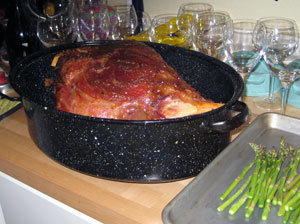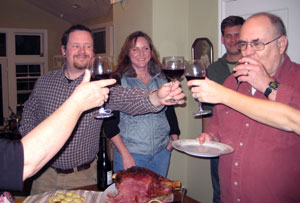My dad grew up in West Virginia, and is a true lover of good 'ol Southern food. Biscuits and gravy, slow-smoked ribs, fried chicken, creamy potato salad, braised greens, key lime pie, and country ham with red-eye gravy. Now, I've been hearing about country ham for a good long while, but having grown up in Texas, which isn't really the South (but definitely shares many qualities), I had actually never tasted it.
Country hams have a long history in the South. These traditional American hams are salt-cured, usually in a salt brine, which dries them out and preserves them (this is how succulent pig legs were preserved prior to refrigeration). They are then typically smoked, although there are very delicious examples of unsmoked country ham. From what I can tell, the best seem to come from Virginia or North Carollna. In fact, you might have heard of Virginia ham or Smithfield ham, which are both examples of country hams from Virginia. Smithfield hams seem to be the most highly revered, and are aged longer than other country hams. Apparently they are also more deeply flavored and saltier. Each region seems to have their own particular style.
So, this past weekend, for my dad's 70th birthday, we decided to not only fly up to Portland and surprise him, but also give him a true-blue (well, it wasn't really blue) country ham. In fact, we even went one step further, and threw him a birthday party where he, and the ham, were the guests of honor.
But getting the ham did take some planning. First, you need to find a reputable place that sells real, exceptional country hams. I had read an article about Calhoun's Country Hams in Saveur, and so I thought, not really knowing where else to turn, to give them a call. I was greeted on the phone with true down-home Southern hospitality. They answered all my questions, and I figured out what I wanted: a 15-lb (the smallest available) uncooked bone-in country ham, which takes about 7-10 business days to ship. Because the hams are salt-cured, you do not have to refrigerate them, as long as you keep them in a cool place (like my brother's basement, next to his Kegerator) and make sure they stay nice and dry.

